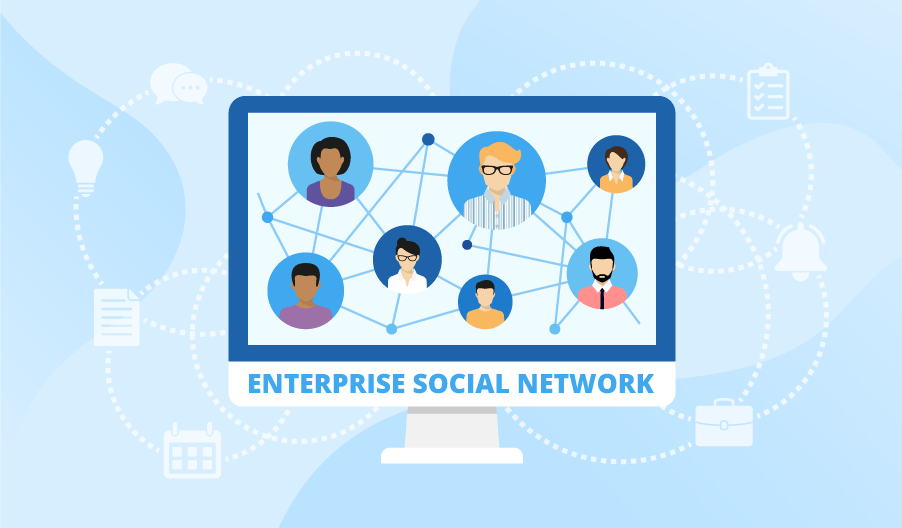How to Derive Benefit from Corporate Social Networking
Today, businesses widely adopt enterprise social networks (ESN), internal tools designed in the mould of popular social media like Facebook and Twitter. Their aim is to make the most of such benefits of social media as facilitated access to information and increased vertical and horizontal communication and thus enhance employee collaboration.
Based on enterprise collaboration solutions we at ScienceSoft develop for our clients, we name the main use cases for the enterprise social network, popular enterprise social networking software. We also give tips on how to implement and use ESN effectively to bring value to your company.

Use cases for the enterprise social network
We implement enterprise social networking to streamline our customer’s work through:
- Discussions. Employees can discuss work-related issues like activities on a current project, corporate policies or industry news. Also, ESN can help employees arrange informal discussions related to hobbies, sports events, corporate events, and birthday parties.
- Ideas and input generation. This is a two-way process. On the one hand, employees share files or links to articles, statistics, research that they consider useful with their colleagues. On the other hand, employees post to ESN their requests for input concerning policies, projects and tasks, solving technical issues, ordering supplies, and more. Thus, ESN serves as a knowledge management solution and helps employees solve their specific work-related problems quickly.
- Notifications about updates and events. Users can apply the enterprise social network to notify others about completing projects or research, getting promoted, relocated, and more. Also, they can announce upcoming events like a training session, a workshop or a presentation, promote them and encourage others to join them.
- Task management. ESN can help employees coordinate tasks, which is especially important for tasks that require input from several people in a specific order (e.g., contract approval). An ability to track tasks of other team members helps keep them on the same page.
Enterprise social networking tools
ESN can be implemented in two forms – as standalone tools and fully fledged collaboration platforms. Let’s have a closer look at these options.
Standalone tools
Among popular standalone tools that can be used as ESN are:
- Slack, a messaging app that offers internal and external file sharing, message archiving and advanced search. It also enables voice and video calling and is available on mobile devices.
- Workplace by Facebook, a business-focused twin of the well-known social platform tailored to messaging and team collaboration. It’s used for creating profiles, uniting people in groups, sharing information, organizing events, and more.
- Chatter by Salesforce, a social tool that empowers users to connect, collaborate, and share files in real time. It provides a forum for sharing knowledge as well as enables creating polls.
From the experience in the development of collaboration solutions, ScienceSoft suggests that using a standalone ESN solution can’t be as effective as a robust collaboration platform. Without being able to integrate with other internal systems, corporate social media can’t ensure the continuity of enterprise business processes and improve employee collaboration in the long run.
Collaboration platforms
Such ESN are usually built on a digital backbone of an organization, which can be an intranet, a portal, CRM, etc. ScienceSoft has been developing collaboration solutions on SharePoint since 2007, and we’d like to share our view on implementing ESN with a SharePoint intranet as a basis.
We see a foundation of effective ESN in an advanced version of a social-oriented intranet. A SharePoint-based social intranet offers communication features like chats, forums, communities, blogs, discussion boards, and more. But this social-oriented intranet still lacks the functionality of dedicated social tools, for example, video conferencing. To handle this challenge, a SharePoint social intranet can be easily integrated with robust communication and collaboration tools of the Office 365 suite, such as:
- Yammer, an Office 365 collaboration application that gathers, stores and categorizes conversations as well as offers robust analytics and reporting based on them. Yammer easily integrates with third-party tools and is mobile-friendly.
- Microsoft Teams, an Office 365 tool designed for team collaboration. It helps create isolated and secure collaboration areas where team members communicate, share files, and work on projects together.
Such integration helps create ESN that takes the best of both worlds: collaboration tools will help ensure effective employee communication, and intranet capabilities will piece together communication with customers and related projects or documents and make them searchable and retrievable. This combined solution allows businesses to streamline business processes, avoid information silos, duplication and confusion of new and outdated documents, and enhance collaboration.
Best practices of effective ESN implementation
We recommend the following best practices that will help your enterprise social networking tool bring value to your organization:
- Providing internal training. Due to multiple features and integrations, ESN tools can be difficult to adopt. We arrange training for employees where ESN experts will show them how to use this technology effectively in order to achieve their working goals.
- Tracking and analyzing user metrics. To be successful, ESN should be a dynamic system continuously improved to adapt to changing business needs. So, we pay much attention to tracking and analyzing such ESN metrics as the number of active users, contribution per user (content items, comments, ratings), and more. This helps make ESN more user-friendly, add wanted features to ESN and remove useless ones.
- Ensuring security and compliance. Free sharing of information, links and files over ESN creates a risk of security breaches. It can be critical for regulated industries as security breaches may incur heavy fines. So, we equip ESN with a set of security mechanisms like permission levels that ensure the protection of sensitive information and prevent users from viewing, sharing, saving on desktops and printing out certain content.
Want to connect all your employees and improve collaboration?
We help companies build effective ESN by equipping a SharePoint social intranet with a set of advanced communication features.

